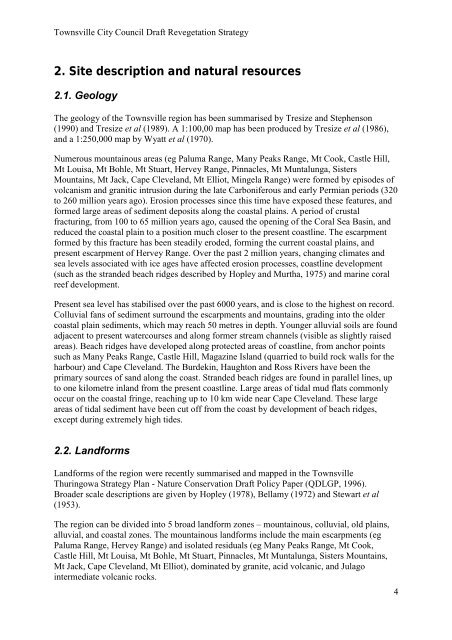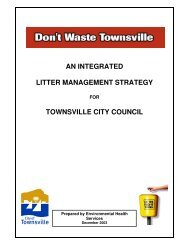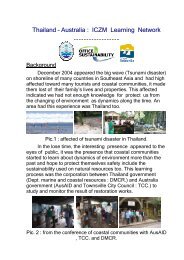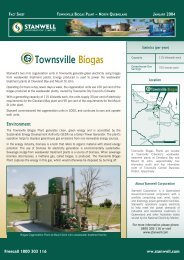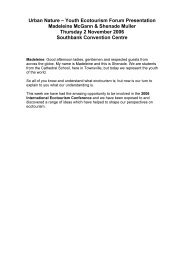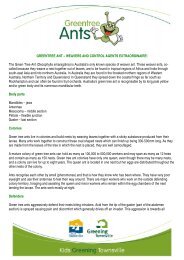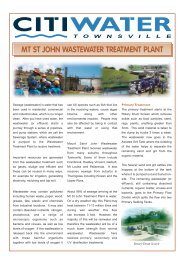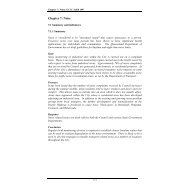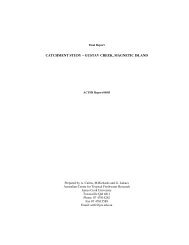Revegetation Strategy - Townsville State of the Environment Report
Revegetation Strategy - Townsville State of the Environment Report
Revegetation Strategy - Townsville State of the Environment Report
Create successful ePaper yourself
Turn your PDF publications into a flip-book with our unique Google optimized e-Paper software.
<strong>Townsville</strong> City Council Draft <strong>Revegetation</strong> <strong>Strategy</strong><br />
2. Site description and natural resources<br />
2.1. Geology<br />
The geology <strong>of</strong> <strong>the</strong> <strong>Townsville</strong> region has been summarised by Tresize and Stephenson<br />
(1990) and Tresize et al (1989). A 1:100,00 map has been produced by Tresize et al (1986),<br />
and a 1:250,000 map by Wyatt et al (1970).<br />
Numerous mountainous areas (eg Paluma Range, Many Peaks Range, Mt Cook, Castle Hill,<br />
Mt Louisa, Mt Bohle, Mt Stuart, Hervey Range, Pinnacles, Mt Muntalunga, Sisters<br />
Mountains, Mt Jack, Cape Cleveland, Mt Elliot, Mingela Range) were formed by episodes <strong>of</strong><br />
volcanism and granitic intrusion during <strong>the</strong> late Carboniferous and early Permian periods (320<br />
to 260 million years ago). Erosion processes since this time have exposed <strong>the</strong>se features, and<br />
formed large areas <strong>of</strong> sediment deposits along <strong>the</strong> coastal plains. A period <strong>of</strong> crustal<br />
fracturing, from 100 to 65 million years ago, caused <strong>the</strong> opening <strong>of</strong> <strong>the</strong> Coral Sea Basin, and<br />
reduced <strong>the</strong> coastal plain to a position much closer to <strong>the</strong> present coastline. The escarpment<br />
formed by this fracture has been steadily eroded, forming <strong>the</strong> current coastal plains, and<br />
present escarpment <strong>of</strong> Hervey Range. Over <strong>the</strong> past 2 million years, changing climates and<br />
sea levels associated with ice ages have affected erosion processes, coastline development<br />
(such as <strong>the</strong> stranded beach ridges described by Hopley and Murtha, 1975) and marine coral<br />
reef development.<br />
Present sea level has stabilised over <strong>the</strong> past 6000 years, and is close to <strong>the</strong> highest on record.<br />
Colluvial fans <strong>of</strong> sediment surround <strong>the</strong> escarpments and mountains, grading into <strong>the</strong> older<br />
coastal plain sediments, which may reach 50 metres in depth. Younger alluvial soils are found<br />
adjacent to present watercourses and along former stream channels (visible as slightly raised<br />
areas). Beach ridges have developed along protected areas <strong>of</strong> coastline, from anchor points<br />
such as Many Peaks Range, Castle Hill, Magazine Island (quarried to build rock walls for <strong>the</strong><br />
harbour) and Cape Cleveland. The Burdekin, Haughton and Ross Rivers have been <strong>the</strong><br />
primary sources <strong>of</strong> sand along <strong>the</strong> coast. Stranded beach ridges are found in parallel lines, up<br />
to one kilometre inland from <strong>the</strong> present coastline. Large areas <strong>of</strong> tidal mud flats commonly<br />
occur on <strong>the</strong> coastal fringe, reaching up to 10 km wide near Cape Cleveland. These large<br />
areas <strong>of</strong> tidal sediment have been cut <strong>of</strong>f from <strong>the</strong> coast by development <strong>of</strong> beach ridges,<br />
except during extremely high tides.<br />
2.2. Landforms<br />
Landforms <strong>of</strong> <strong>the</strong> region were recently summarised and mapped in <strong>the</strong> <strong>Townsville</strong><br />
Thuringowa <strong>Strategy</strong> Plan - Nature Conservation Draft Policy Paper (QDLGP, 1996).<br />
Broader scale descriptions are given by Hopley (1978), Bellamy (1972) and Stewart et al<br />
(1953).<br />
The region can be divided into 5 broad landform zones – mountainous, colluvial, old plains,<br />
alluvial, and coastal zones. The mountainous landforms include <strong>the</strong> main escarpments (eg<br />
Paluma Range, Hervey Range) and isolated residuals (eg Many Peaks Range, Mt Cook,<br />
Castle Hill, Mt Louisa, Mt Bohle, Mt Stuart, Pinnacles, Mt Muntalunga, Sisters Mountains,<br />
Mt Jack, Cape Cleveland, Mt Elliot), dominated by granite, acid volcanic, and Julago<br />
intermediate volcanic rocks.<br />
4


